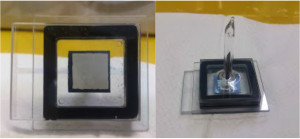
Scientists have developed a new type of energy-efficient flat light source with a power consumption about a hundred times lower than that of an LED.
Credit: N. Shimoi/Tohoku University
Scientists all around the globe are constantly looking for a way to create the even-better-bulb of tomorrow. In order to do this, researchers are looking toward carbon electronics.
This from the American Institute of Physics:
Electronics based on carbon, especially carbon nanotubes (CNTs), are emerging as successors to silicon for making semiconductor materials, and they may enable a new generation of brighter, low-power, low-cost lighting devices that could challenge the dominance of light-emitting diodes (LEDs) in the future and help meet society’s ever-escalating demand for greener bulbs.
With this in mind, scientists from Tohoku University have developed a new type of energy-efficient flat light source with a very low power consumption that comes in around 0.1 Watt for every hour of operation. This is about one hundred times lower than that of an LED.
The researchers detailed their findings in the journal Review of Scientific Instruments. Here, they explain that the device is based on a phosphor screen and single-walled carbon nanotubes as electrodes in a diode structure.
The scientists state that although the device as a diode-like structure, its light-emitting system is not based on a diode system. Instead of layers of semiconductors, the new devices have luminescence systems that function more like cathode ray tubes.
“Many researchers have attempted to construct light sources with carbon nanotubes as field emitter, but nobody has developed an equivalent and simpler lighting device,” Norihiro Shimoi, the lead researcher and an associate professor of environmental studies at the Tohoku University, told the American Institute of Physics.
Check out what are scientists are doing in the field or luminescence and display materials, and read up on the latest research in our Digital Library.

